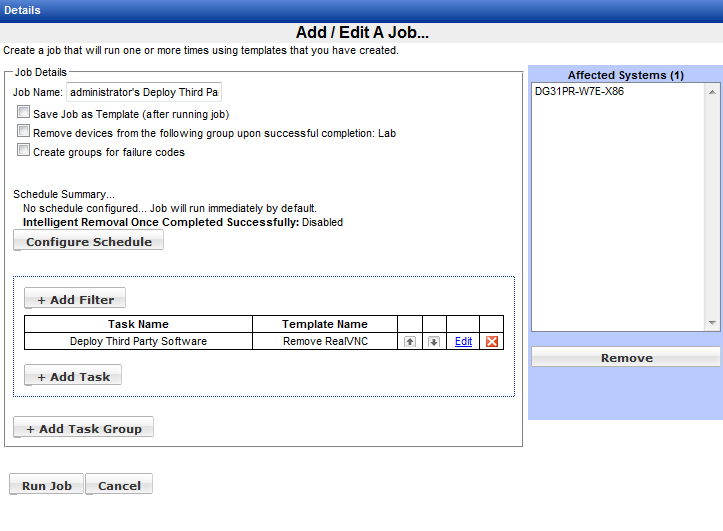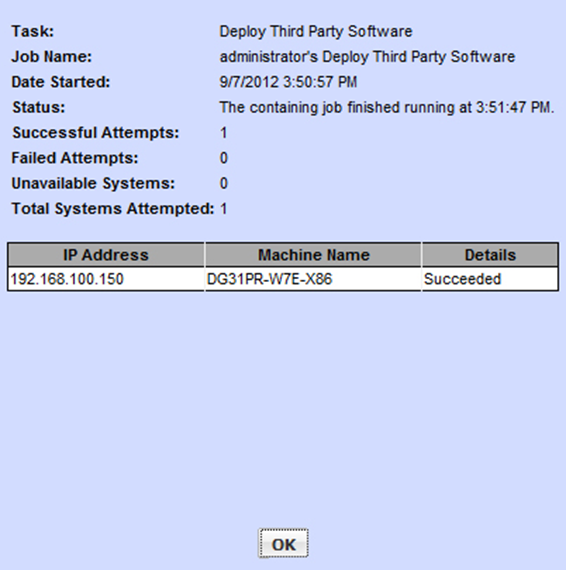Uninstalling RealVNC and UltraVNC
Uninstalling RealVNC and UltraVNC
The Third Party Software Deployment feature of SyAM Management Utilities can be used to perform a silent uninstallation of RealVNC or UltraVNC on Windows client systems.
Requirements: This procedure has been tested with RealVNC versions 4.1.1 and 5.0.5. and UltraVNC version 1.1.9. A system reboot may be required to complete uninstallation.
To remove RealVNC, create a batch file to perform the uninstallation.
@ECHO OFF
REM remove-realvnc.bat
REM Uninstall RealVNC 4 or 5 from 32-bit or 64-bit Windows systems
REM Remove RealVNC 4
IF EXIST "%SystemDrive%\Program Files\RealVNC\VNC4\unins000.exe" "%SystemDrive%\Program Files\RealVNC\VNC4\unins000.exe" /VERYSILENT /NORESTART
IF EXIST "%SystemDrive%\Program Files (x86)\RealVNC\VNC4\unins000.exe" "%SystemDrive%\Program Files (x86)\RealVNC\VNC4\unins000.exe" /VERYSILENT /NORESTART
REM Remove RealVNC 5
IF EXIST "%SystemDrive%\Program Files\RealVNC\VNC Server\unins000.exe" "%SystemDrive%\Program Files\RealVNC\VNC Server\unins000.exe" /VERYSILENT /NORESTART
IF EXIST "%SystemDrive%\Program Files\RealVNC\VNC Viewer\unins000.exe" "%SystemDrive%\Program Files\RealVNC\VNC Viewer\unins000.exe" /VERYSILENT /NORESTART
IF EXIST "%SystemDrive%\Program Files (x86)\RealVNC\VNC Server\unins000.exe" "%SystemDrive%\Program Files (x86)\RealVNC\VNC Server\unins000.exe" /VERYSILENT /NORESTART
IF EXIST "%SystemDrive%\Program Files (x86)\RealVNC\VNC Viewer\unins000.exe" "%SystemDrive%\Program Files (x86)\RealVNC\VNC Viewer\unins000.exe" /VERYSILENT /NORESTART
EXIT
Please note that the IF EXIST statements are single lines, each one ending with the /NORESTART parameter. Save the batch file (in our example we will use the name remove-realvnc.bat) and copy it to the network directory defined as the Default Application Path in the Administration Settings area of the Management Utility.
To remove UltraVNC, create a batch file to perform the uninstallation.
@ECHO OFF
REM remove-ultravnc.bat
REM Uninstall UltraVNC from 32-bit or 64-bit Windows systems
IF EXIST "%SystemDrive%\Program Files\uvnc bvba\UltraVNC\unins000.exe" "%SystemDrive%\Program Files\uvnc bvba\UltraVNC\unins000.exe" /VERYSILENT /NORESTART
IF EXIST "%SystemDrive%\Program Files (x86)\uvnc bvba\UltraVNC\unins000.exe" "%SystemDrive%\Program Files (x86)\uvnc bvba\UltraVNC\unins000.exe" /VERYSILENT /NORESTART
EXIT
Please note that the IF EXIST statements are single lines, each one ending with the /NORESTART parameter. Save the batch file (in our example we will use the name remove-ultravnc.bat) and copy it to the network directory defined as the Default Application Path in the Administration Settings area of the Management Utility.
In Management Utility, create a Third Party template. Enter a template name. Choose Windows as the target platform and select the correct authentication template. Enter the path to the network share containing the batch file; this will already be present if the default path has been entered in Administration Settings. Click the Find Files button and choose one of the newly created batch files from the drop down menu.

Click the Add button.

In this example, we have created a template to uninstall RealVNC. A template for uninstalling UltraVNC would be created in the same way. A single template to run both scripts can also be made, by adding first one batch file and then the other.
When finished, click Save Changes, then click OK to confirm.
Now you can test deployment to a single system. Select a system in the Groups area. Click the system row, then right-click to display the context menu. From the menu, choose Deploy Third Party Software.

In the New Task box, choose the Windows authentication template and the newly created uninstallation template. Click OK.

On the Add/Edit a Job page, click the Run Job button, then click OK to confirm. The job will begin shortly.

After the job is finished, you may review the status by finding the job in the Status area and clicking the View Details link. Remember that a system reboot may be required to complete all uninstallation tasks.

Once you have uninstalled successfully on a single machine, you can use the Groups context menu options to repeat the procedure for multiple client machines.